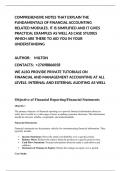Class notes
FINANCIAL ACCOUNTING SIMPLIFIED
- Institution
- University Of South Africa (Unisa)
Tired of dry, boring textbooks? Craving a financial adventure that's as exciting as your favorite binge-worthy show? Look no further! Our comprehensive financial accounting document is your golden ticket to mastering the world of numbers. Dive into a realm where debits and credits collide in a s...
[Show more]



